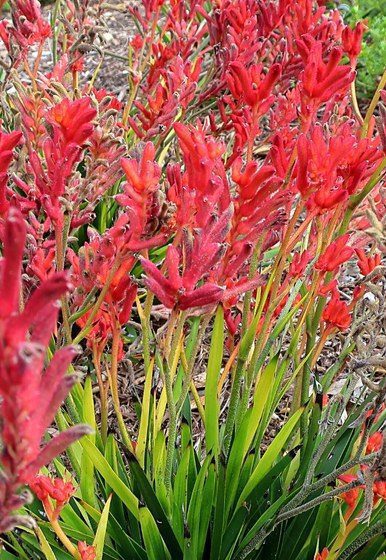The Kangaroo Paw (Anigozanthos flavidus) is a herbaceous, rhizomatous, and flowering species native to the southwestern region of Australia, where it thrives along coastal areas from Two Peoples Bay to Mandurah in the north. Widely renowned for its hardiness and attractive blooming, this plant features furry flowers that resemble kangaroo paws.
It inhabits various environments, including roadsides, riverbanks, swamps, shallow waters, and eucalyptus forests, displaying tolerance for light shade. Growing from rhizomes, it produces large tufts of fan-shaped, ribbon-like leaves that range from upright to gently curving, flat, glossy, perennial, and vivid green, reaching lengths of up to 90cm.

Flowering extends from early spring to mid-autumn. Its erect inflorescences rise above the foliage, reaching heights of up to 3 meters. Each plant produces about ten flower stalks, resulting in a total of approximately 350 flowers per plant. The tubular flowers are covered in velvety hairs, giving them the distinctive appearance of kangaroo paws. However, these hairs can be irritating to the skin and mucous membranes.
The flowers come in vibrant or pastel shades of yellow, orange, red, green, brown, pink, and purple. Numerous cultivars exist based on specific purposes (cut flowers, potted plants, landscaping), with varying sizes and colors. Pollination is carried out by nectar-feeding birds such as hummingbirds and honeyeaters.
In landscaping, the Kangaroo Paw stands out for its versatility, long blooming period, and exotic visual appeal. The tall inflorescences rising above the foliage create an excellent backdrop for shorter species in complementary or analogous colors. Create mass plantings, borders, or combine them with other plants.
Kangaroo Paws thrive in pots and containers, enhancing patios, balconies, and terraces. Their durable flowers are widely used in floral arrangements and bouquets. Interesting fact: Kangaroo Paw is utilized in the cosmetic industry for its skin-regenerative properties.

It should be cultivated in full sun or partial shade, in sandy, loamy, or even clayey, well-draining soil. The Kangaroo Paw is not demanding in terms of fertility and can withstand both periods of waterlogging and drought, as long as they’re not prolonged. Similar to other Australian plant species, it’s not fond of fertilizers high in phosphates, so it’s best to avoid them.
Opt for slow-release fertilizers for this species. While consistent moisture during flowering is ideal, you can reduce watering in winter. It’s susceptible to black spot (Alternaria sp) and snails. In case of disease, drastic pruning is recommended, removing all leaves. It doesn’t tolerate prolonged cold or frost.
Propagation is achieved through seeds or division of clumps, ensuring each new plant has roots, rhizomes, and leaves. Harvest seeds in autumn. They might have dormancy that can be broken through heat treatment. Sow in moist sandy substrate and await germination in 15 to 40 days.

